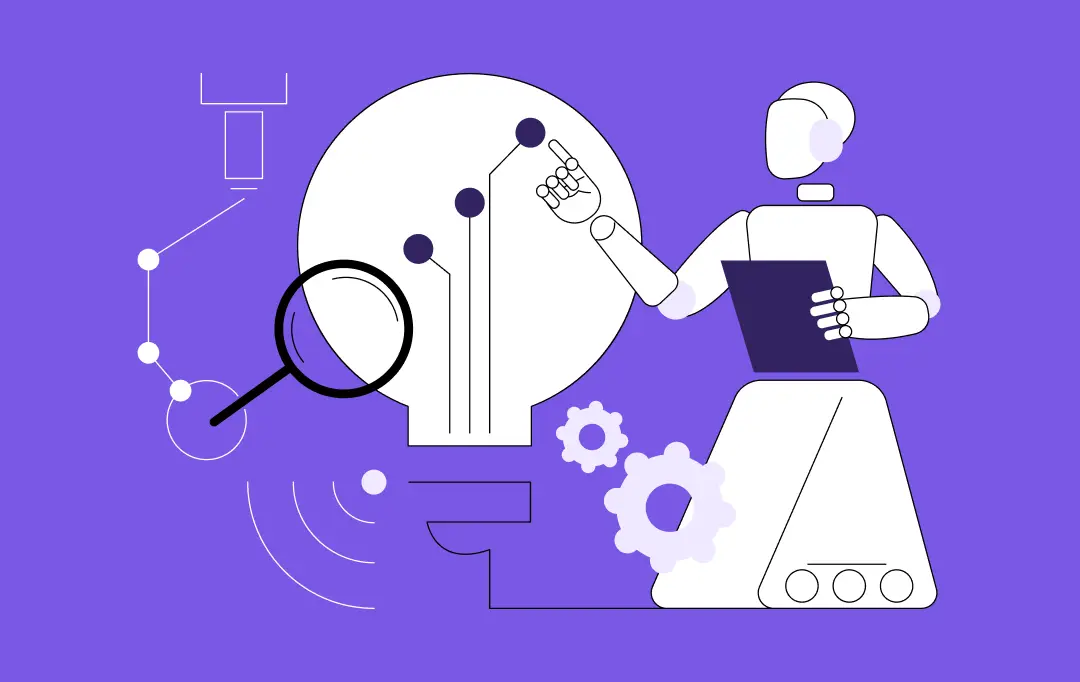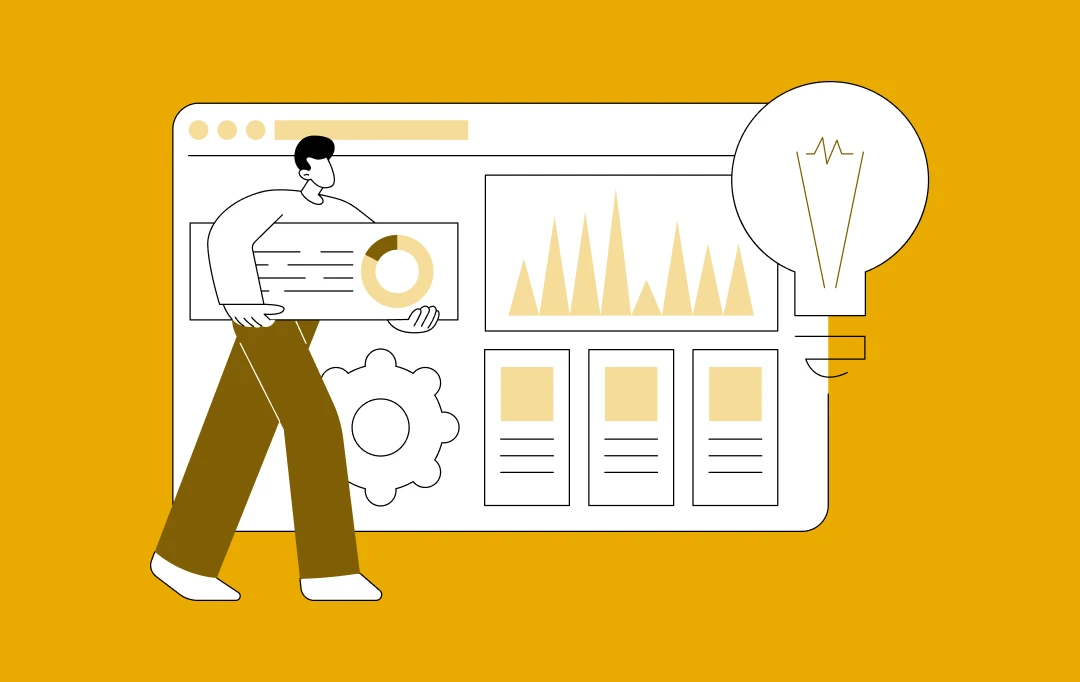Key takeaways:
- ERP integration enables operational efficiency, reduced costs, and enhanced decision-making.
- Healthcare, finance, manufacturing, retail, and all the other sectors are benefiting from ERP integrations in Australia.
- While ERP integration can be costly, ranging from AUD 45,000 – AUD 450,000, it leads to significant long-term savings and scalability.
- Compliance with Australian regulations is critical, and Appinventiv ensures seamless and secure ERP implementation.
Ever feel like your business is juggling too many balls? You have got sales data here, inventory figures there, and customer service notes somewhere else entirely. For many Australian enterprises, this isn’t just an imagination; it’s the frustrating reality of operating with a patchwork of disconnected systems. This fragmentation creates a silent drain on your resources, leading to a host of headaches:
- Wasted Time & Errors: Your team spends hours manually moving data between different software, leading to costly mistakes and less time for strategic work.
- Missed Opportunities: Without a unified view of your operations, it’s challenging to identify trends, respond promptly to market shifts, or make truly informed decisions.
- Operational Bottlenecks: Processes become clunky and slow, from order fulfillment to financial reporting, hindering your ability to serve customers efficiently.
- Customer Dissatisfaction: Inconsistent information and disjointed interactions frustrate your customers, potentially driving them to competitors.
- Stifled Growth: As your business scales, these system limitations become major roadblocks, making expansion harder than it needs to be.
The good news? You are not alone, and there is a powerful solution — “ERP integration”. The Australian ERP software market is booming, expected to hit $1.08 billion by 2030, growing at a 2.78% CAGR from 2025.
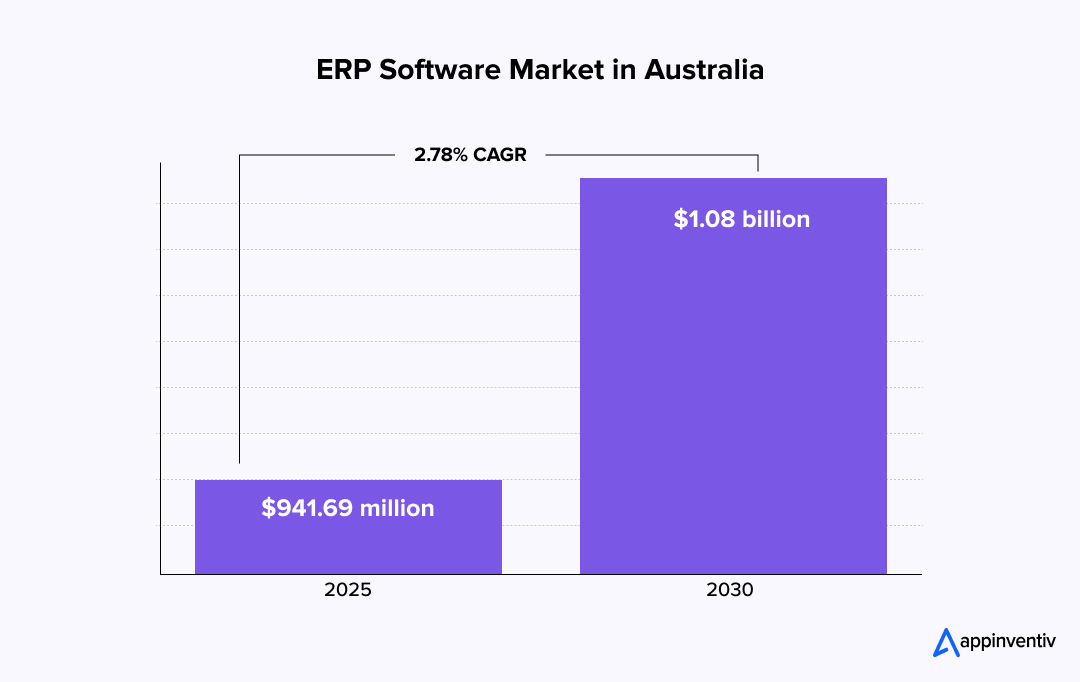
This is not just a number; it reflects that ERP integration in Australia has become a critical strategy for businesses to unlock their full potential.
So, why is ERP software integration in Australia so essential for modern enterprises, and how can you ensure your ERP implementation gets it right? Let’s dive in.
Beyond Basics: Understanding Why ERP in Australia is Essential for Modern Enterprises?
At its core, ERP software integration in Australia involves connecting various enterprise resource planning modules and other disparate business applications into a unified, cohesive system. This single, integrated platform enables the seamless flow of data across all departments and functions, transforming the way a business operates. The convergence of several factors has made the implementation of ERP in Australia not just attractive but essential for businesses.
Market Trends and Digital Transformation Imperatives for Australia
Australia is in the midst of a profound digital transformation. With an increasing focus on digitalization and rising investment in both the public and private sectors, the demand for advanced software to manage operations and improve workflows is escalating.
The service sector, accounting for a substantial 63.6% of Australia’s GDP in 2023, is a key driver in the adoption of advanced solutions. As more industries expand in the country, a robust ERP system in Australia becomes critical for making informed decisions and remaining competitive. This shift reflects a global trend where digital maturity is no longer a luxury but a necessity for survival and growth.
Also Read: A detailed guide to custom mobile ERP solution development
The Unseen Hurdles: Why Australian Businesses Struggle with Disconnected Systems
For many Australian enterprises, the reality of daily operations involves navigating a labyrinth of disparate software. From accounting packages to CRM systems, inventory management to HR platforms, these systems often operate in isolation, creating significant friction and inefficiency. Let’s dig into these hurdles in detail:
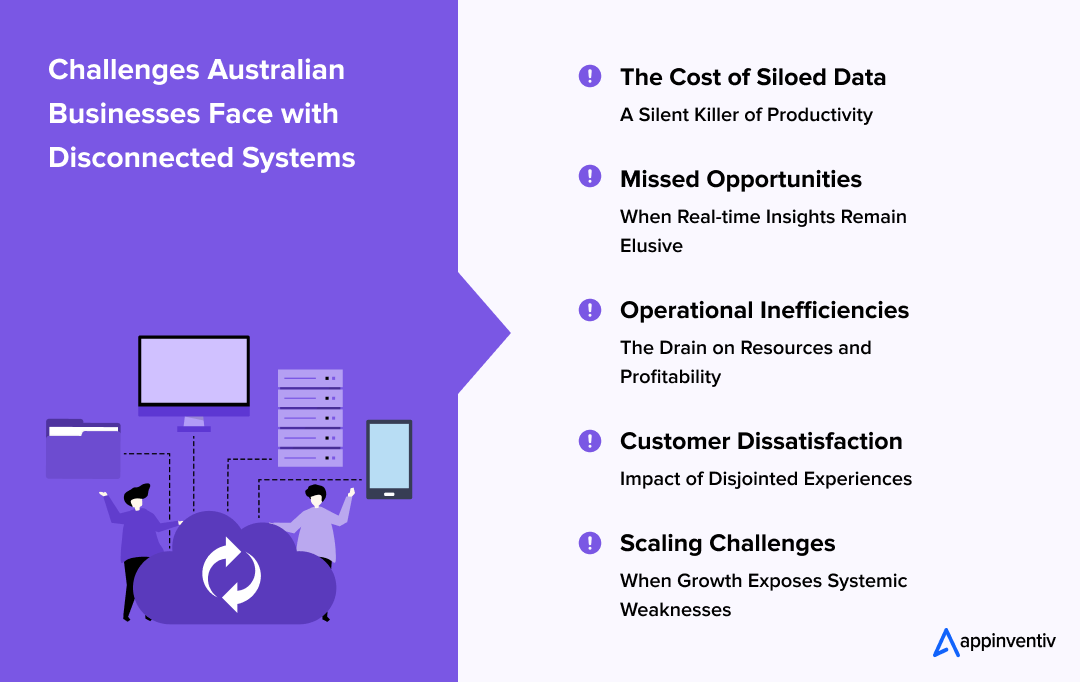
The Cost of Siloed Data: A Silent Killer of Productivity
When critical business data resides in separate silos, the implications are far-reaching. Employees spend countless hours manually transferring data between systems, leading to errors, redundancies, and a significant drain on productivity.
This “distraction tax,” as Forbes describes it, represents the cumulative hours employees spend on manual, repetitive tasks and inefficient processes, potentially reducing productive time by up to 40%.
For a business, this translates directly into higher operational costs and a diversion of valuable human capital from strategic initiatives to mundane data management.
Missed Opportunities: When Real-time Insights Remain Elusive
In today’s fast-paced market, timely and accurate data are the bedrock of informed decision-making. However, with disconnected systems, getting a holistic, real-time view of business performance is often an arduous task.
Imagine trying to forecast demand without synchronized sales, inventory, and supply chain data. Opportunities for optimizing operations, identifying new market segments, or responding swiftly to customer needs are frequently missed, leaving businesses trailing their more agile competitors.
Operational Inefficiencies: The Drain on Resources and Profitability
From elongated order-to-cash cycles to inefficient supply chain management, disconnected systems directly contribute to operational inefficiencies. Manual handoffs, approval bottlenecks, and a lack of transparency result in wasted resources, which ultimately have a detrimental impact on the bottom line.
As businesses scale, these inefficiencies become amplified, turning what might have been minor annoyances into significant roadblocks.
Customer Dissatisfaction: Impact of Disjointed Experiences
Modern customers expect seamless and personalized interactions. When sales, service, and fulfillment teams lack a unified view of customer interactions and order history, the customer experience suffers. Inconsistent information, delayed responses, and fragmented service journeys can quickly lead to dissatisfaction and churn, ultimately undermining customer loyalty and damaging the brand’s reputation.
Over 50% of customers prefer to switch to a competitor after just one unsatisfactory experience (Source: Zendesk).
Also Read: AI in Customer Experience: Revolutionizing Business Growth
Scaling Challenges: When Growth Exposes Systemic Weaknesses
As an Australian business grows, the limitations of unintegrated systems become acutely apparent. Adding new product lines, expanding into new markets, or increasing transaction volumes can overwhelm a fragmented IT infrastructure, leading to breakdowns, errors, and a significant impediment to sustainable growth.
The very growth that businesses strive for can, paradoxically, become a source of immense operational stress without the right foundational technology.
Key Benefits of ERP Integration in Australia
ERP integration streamlines business operations by centralizing data, improving workflow automation, and ensuring real-time visibility across departments. With better collaboration and a single source of truth, ERP integration is a game-changer for Australian enterprises looking to stay competitive and efficient. Let’s dive deeper to uncover how ERP implementation is benefiting the Australian market:
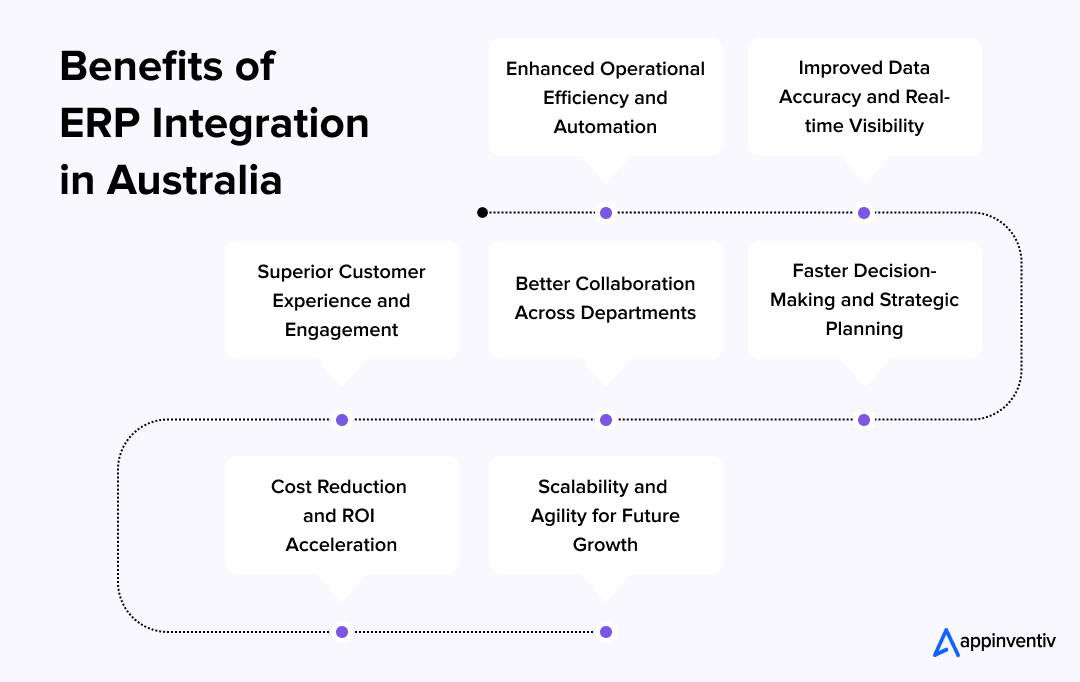
Enhanced Operational Efficiency and Automation
An integrated ERP system automates numerous manual tasks, such as data entry, order processing, and financial reporting. This reduces human error and frees up employees to focus on higher-value activities. For instance, automating inventory updates and procurement alerts, and using predictive analytics for demand forecasting, can significantly streamline operations.
Improved Data Accuracy and Real-time Visibility
By establishing a single source of truth, ERP system integration eliminates data inconsistencies and provides real-time insights across all business functions. This improved accuracy is paramount for effective decision-making.
Faster Decision-Making and Strategic Planning
With immediate access to accurate, comprehensive data, Australian enterprises can make faster, more informed decisions. Leveraging AI/ML capabilities with rich ERP data can unlock predictive analytics, allowing businesses to anticipate future trends and plan strategically. In short, ERP acts as a “transformation engine,” providing deep process insights for smarter decision-making.
Better Collaboration Across Departments
One of the top reasons organizations implement ERP into the processes is to combine data and break down operational silos to improve performance. How? ERP software integration breaks down communication barriers between departments. Sales teams have real-time visibility into inventory, customer service agents can access order history, and finance teams can track all transactions in one place.
Superior Customer Experience and Engagement
A unified view of customer interactions and orders, often through CRM ERP integration, enables businesses to provide personalized service, quick responses, and accurate order updates. This seamless experience translates into higher customer satisfaction and brand loyalty.
Cost Reduction and ROI Acceleration
By streamlining operations, reducing errors, optimizing resource allocation, and improving decision-making, ERP integration leads to significant cost savings. Cost reductions occur through multiple mechanisms, such as eliminating duplicate data entry, which reduces labor costs; improved accuracy reduces error correction expenses; automated processes reduce operational overhead; and better visibility enables optimized resource allocation. These savings compound over time, creating substantial long-term value and return on investment (ROI).
Scalability and Agility for Future Growth
A well-integrated ERP system provides a scalable foundation that can easily accommodate business growth, new product lines, and market expansions without requiring a complete overhaul of the IT infrastructure. This agility is crucial for adapting to evolving market demands.
Industry Spotlight: ERP Integration Use Cases Across Australian Sectors
The diverse economic landscape of Australia means that the specific benefits of ERP integration for different industries in Australia can vary significantly. However, the underlying principle of unifying data and processes remains universally essential. Here are industry-wise use cases of ERP integration:
Healthcare
The Australian healthcare sector faces unique challenges, including complex patient data management, intricate billing processes, and stringent regulatory compliance.
Pain Points: Fragmented patient records across various departments and clinics, inefficient billing systems leading to revenue leakage, complexities in managing medical supplies inventory, and ensuring compliance with regulations like the My Health Record Act 2012.
Use Cases: An integrated ERP system in healthcare can facilitate centralized patient management, allowing seamless access to patient history, appointments, and treatment plans. It can automate billing and insurance claims, significantly reducing administrative burden and improving cash flow.
Furthermore, it enables precise inventory management for pharmaceuticals and medical equipment, preventing stockouts and optimizing procurement. AI driven real-time analytics can be leveraged for resource allocation, optimizing staff scheduling, and facility utilization.
Manufacturing & Distribution
Australian manufacturers and distributors often grapple with complex supply chains and the need for precision in production and inventory.
Pain Points: Supply chain disruptions impacting production schedules, inaccurate inventory levels leading to overstocking or stockouts, production bottlenecks due to a lack of real-time visibility, and issues with quality control across the production line.
Use Cases: Australian ERP integration in manufacturing provides end-to-end supply chain visibility, allowing businesses to track goods from raw materials to finished products. It automates order processing and optimizes warehouse management, reducing manual errors and speeding up fulfillment.
Real-time production monitoring helps identify and resolve bottlenecks quickly, while predictive maintenance capabilities in manufacturing, leveraging IoT data, prevent costly equipment failures.
Retail & eCommerce
The rise of online shopping necessitates seamless integration between brick-and-mortar and digital channels.
Pain Points: When online and offline sales data remain disconnected, it causes inconsistent inventory information and disrupts the customer experience. This often leads to inaccurate stock levels, resulting in overselling or missed sales opportunities. Additionally, managing complex order fulfillment across multiple channels becomes challenging, while inconsistent customer data across loyalty programs and sales platforms further hampers personalized service.
Use Cases: Ecommerce integration with ERP creates an omnichannel customer experience, where online and in-store interactions are unified. It provides unified inventory management across all channels, ensuring accurate stock levels and preventing stockouts.
Automated order fulfillment streamlines the pick, pack, and ship process. Personalized marketing and sales efforts are enhanced through a 360-degree view of customer purchasing habits and preferences
Finance
The finance sector requires the highest levels of precision and security due to the sensitive nature of financial data and transactions.
Pain Points: Stringent regulatory compliance requirements, paramount data security concerns, disparate financial reporting tools leading to reconciliation issues, and complex risk management processes.
Use Cases: An ERP system integration in finance ensures centralized financial reporting, providing a single, accurate view of all financial transactions. It facilitates automated compliance checks, reducing manual effort and minimizing regulatory risks.
Enhanced fraud detection capabilities, leveraging integrated data, protect both the institution and its clients. Real-time financial analytics support agile decision-making and risk assessment.
Other Key Industries
While the above industries showcase significant examples, ERP integration for Australian enterprises extends across various sectors. For instance:
- Government: ERP systems can streamline public service delivery, enhance transparency, and improve citizen engagement by integrating multiple administrative functions into a single platform.
- Education: Integration unifies student information systems with administrative, financial, and learning management platforms, enabling smoother operations and better data-driven decisions.
- Agriculture: ERP helps optimize farm management by linking crop planning, resource allocation, and supply chain logistics, integrating real-time field data with operational systems for improved productivity and traceability.
- Supply Chain & Logistics: ERP integration provides end-to-end visibility, enabling real-time tracking, inventory management, and demand forecasting to reduce delays and improve efficiency across distribution networks.
- Automotive: ERP integration in the automotive sector automates production scheduling, quality control, and supplier management, ensuring compliance with industry standards while optimizing manufacturing workflows.
- Real Estate: ERP solutions unify property management, sales, leasing, and financial operations, offering comprehensive insights that improve decision-making, tenant relations, and regulatory compliance.
The Blueprint for Success: A Step-by-Step ERP Integration Process
A successful ERP integration process is not merely about technology; it is about a carefully planned and executed transformation that ensures minimal disruption and maximum benefit. Here are the common ERP integration steps:
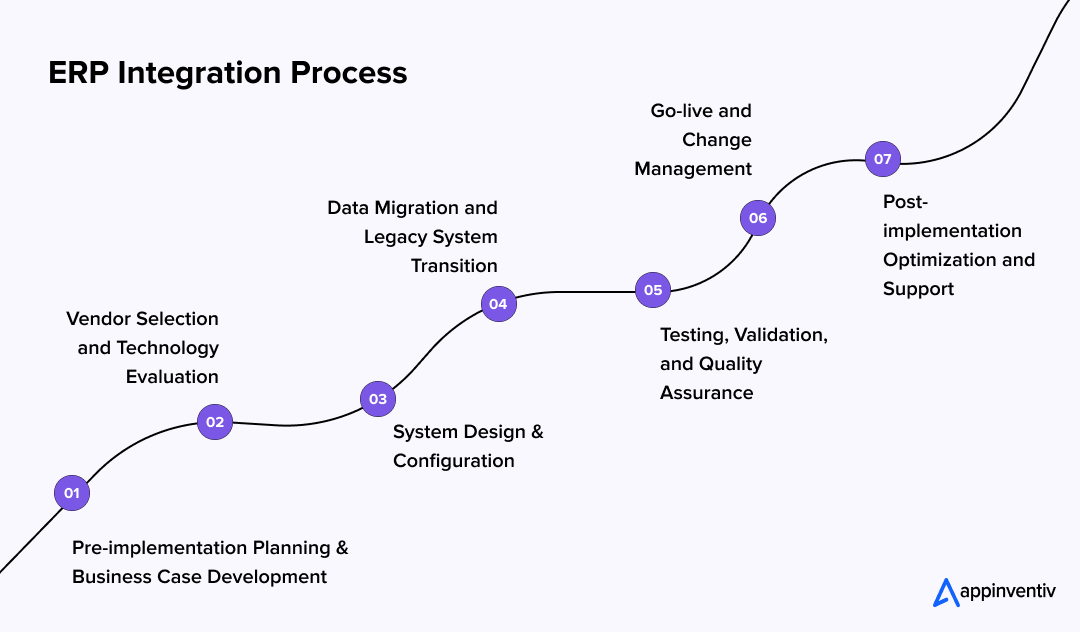
Pre-implementation Planning and Business Case Development
This foundational phase involves defining the “why” behind the integration. It begins with a thorough assessment of current pain points, identifying specific business goals (e.g., reduce order processing time by 30%, improve data accuracy by 50%).
A clear business case outlining expected ROI and strategic alignment is crucial. This is also where an organization determines its functional requirements, ensuring the chosen ERP system in Australia aligns with specific operational needs.
Vendor Selection and Technology Evaluation
Choosing the right ERP vendor and integration partner is paramount. This involves evaluating various ERP solutions (cloud-based vs. on-premise), assessing their suitability for the business’s size and industry, and reviewing the vendor’s track record and support
If you are not sure how to choose the right vendor, consult with a reputed software development company in Australia with extensive experience in ERP integration. They will not only guide you in selecting the right vendor, but also stand by you throughout the ERP integration process from start to end and even beyond.
System Design and Configuration
Once a vendor is selected, the design phase begins. This involves mapping existing workflows to the new ERP system, identifying areas for process re-engineering, and configuring the ERP to meet specific business requirements. Data architecture, security protocols, and user roles are meticulously defined.
Data Migration and Legacy System Transition
One of the most critical and often challenging steps is data migration. It involves extracting, transforming, and loading historical data from legacy systems into the new ERP. Data cleansing and validation are crucial to ensure accuracy and prevent the transfer of erroneous information. A phased approach to migrating from legacy systems can help minimize disruption.
Related Article: Cloud Data Migration Strategy and Best Practices
Testing, Validation, and Quality Assurance
Rigorous testing is non-negotiable. This includes unit testing (individual components), integration testing (ensuring seamless data flow between modules and integrated systems), and User Acceptance Testing (UAT), where end-users validate the system’s functionality and usability against real-world scenarios. Comprehensive quality assurance identifies and rectifies any bugs or inefficiencies before go-live.
Go-live and Change Management
The go-live phase marks the official switch to the new ERP system. This can be a “big bang” approach (all at once) or a phased rollout, depending on the business’s risk appetite and complexity. Effective change management is paramount during this phase.
This involves communicating the benefits to employees, addressing their concerns, and providing extensive training. Lack of adequate user training and employee resistance are common pitfalls in ERP implementations, highlighting the importance of a well-executed change management strategy.
Post-implementation Optimization and Support
Implementation is not the end; it’s the beginning of an ongoing journey. Post-go-live, continuous monitoring of system performance, regular audits, and timely updates are essential. Businesses should also plan for ongoing support, user feedback mechanisms, and iterative improvements to maximize the long-term value of their ERP investment.
A well-executed ERP integration strategy can deliver a significant return on investment within a few years, transforming the enterprise into a more agile, efficient, and profitable entity. If you are still unsure which ERP system can be the best fit for your business, how to implement it into your business, or have any other concerns, here is our comprehensive guide on ERP integration to help you out.
The Investment Factor: Demystifying ERP Integration Costs in Australia
A common concern for Australian businesses considering ERP software integration is the associated cost. It’s crucial to view this not as an expenditure, but as a strategic investment with a significant long-term return. The cost of ERP software integration in Australia can vary widely, influenced by several key factors.
Factors Influencing ERP Integration Cost:
- Business Size and Complexity: Larger enterprises may need more customized ERP solutions, which drive up costs.
- Level of Customization: Customization can add 10-30% to the overall ERP implementation budget.
- Data Migration Complexity: Businesses with large volumes of data will incur higher costs for migration.
- Number of Systems to Integrate: The more disparate systems (e.g., CRM, HRM, accounting, inventory) that need to be connected, the higher the integration complexity and, consequently, the cost.
- Integration Technology and Tools: The choice of tech stack, such as integration platform, middleware, or bespoke API development, influences the technical cost component.
- Maintenance and Updates: Typically, the annual maintenance and support cost for an ERP system is 15-20% of the initial software cost.
Typical ERP Integration Cost & Timeline Estimates
While it’s challenging to provide exact figures due to the bespoke nature of each project, here are estimated cost ranges for ERP integration in Australia:
| Business Size |
Cost Estimate (AUD) |
Timeline |
| Small Businesses |
AUD 45,000 – AUD 100,000 |
3 to 6 months |
| Mid-Market Businesses |
AUD 100,000 – AUD 200,000+ |
6 to 9 months |
| Enterprise-Level |
AUD 200,000 – AUD 450,000+ |
9 months to 1 year or more |
These figures generally encompass software licenses, implementation services, data migration, and initial training.
Also Read: ERP Software Development Cost: Estimating Budget in 2024
What Kind of Challenges Do Enterprises Face During ERP Integration, and How Can They Be Mitigated?
While the benefits of ERP integration are compelling, the journey itself is not without its hurdles. Australian enterprises can encounter significant challenges during implementation. Recognizing these pitfalls and proactively planning for them is key to a successful outcome. Some of the most common obstacles and the strategies to overcome them include:
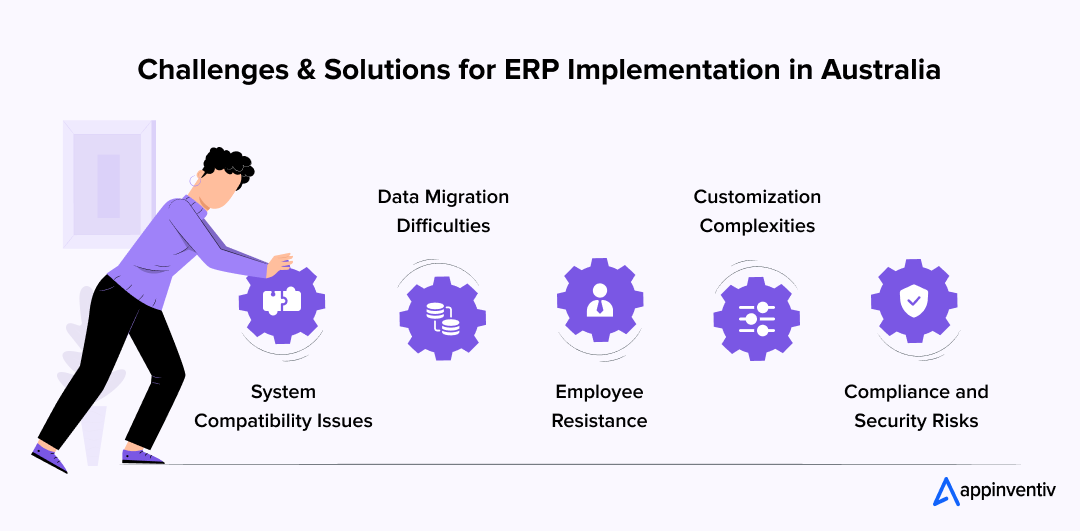
System Compatibility Issues
Challenge: Legacy systems may not easily integrate with modern ERP solutions, causing compatibility problems.
Mitigation: A careful selection of an ERP system that supports both old and new systems, or using middleware, can resolve these issues.
Also Read: Legacy Application Modernization Strategy: A Complete Guide
Data Migration Difficulties
Challenge: Migrating large volumes of data without errors is a common concern.
Mitigation: Employing experienced data migration teams and testing the data transfer process ensures accuracy and a smooth transition.
Employee Resistance
Challenge: Employees may be resistant to change, particularly if they are used to outdated systems.
Mitigation: Comprehensive training programs and involving employees early in the process can help gain buy-in and ease the transition.
Customization Complexities
Challenge: Tailoring ERP systems to fit unique business needs can be time-consuming and costly.
Mitigation: Focus on a cloud based, scalable ERP solution that balances out-of-the-box functionalities with necessary customization, ensuring future flexibility.
Compliance and Security Risks
Challenge: Ensuring that the ERP system meets industry regulations and security standards can be tricky.
Mitigation: Collaborating with ERP implementation providers like Appinventiv, who have deep knowledge of Australian compliance standards, ensures systems are fully compliant.
Navigating the Regulatory Landscape: Compliance & How Appinventiv Can Help
For any enterprise, particularly in Australia, navigating the complex web of data privacy and security regulations is crucial for a successful ERP implementation. Non-compliance can lead to significant financial penalties, reputational damage, and legal repercussions. Here are some of the most essential Australian data privacy and security regulations:
- Privacy Act 1988 (Cth): This legislation governs the collection, use, storage, and disclosure of personal information. For ERP systems handling sensitive data, strict adherence to the Australian Privacy Principles (APPs) within this Act is mandatory.
- Australian Information Security Manual (ISM): The ISM provides a cybersecurity framework that organizations can apply to protect their systems from cyber threats. For ERP solutions, aligning with ISM guidelines is essential for robust data security.
- Industry-Specific Regulations: Beyond general privacy laws, specific industries have additional compliance requirements for ERP integration. For instance, financial services regulated by APRA must follow CPS 230 and CPS 231, while the healthcare sector must comply with the My Health Records Act 2012 for managing patient data.
- Contractual Considerations for ERP Vendors & Integrators: When engaging with ERP vendors or integrators, Australian enterprises must pay close attention to contractual clauses related to:
- Limitation of Liability
- Information Security and Data Loss/Corruption
- Supply Chain Awareness and ESG Compliance
- AI Clauses and compliances
How Appinventiv Ensures Compliance and Seamless Implementation
For Australian entrepreneurs wondering, “How to ensure that integrated systems meet industry-specific compliance standards in AU?”, partnering with a reputed firm is key. Appinventiv, as a leading software development company in Australia, understands the critical importance of regulatory adherence:
- Deep Understanding of Australian Regulations: Our skilled 1600+ tech experts are intimately familiar with the nuances of the Privacy Act, ISM, APRA standards, and industry-specific legislation, ensuring your ERP integration is built with compliance as a core principle.
- Robust Security Protocols: We embed industry-leading security measures, including encryption, access controls, and regular vulnerability assessments, to protect sensitive data within your ERP ecosystem.
- Compliance Auditing and Reporting: We integrate features that facilitate easy auditing and reporting, helping businesses demonstrate adherence to regulatory bodies.
- Focus on ‘Adopt Rather Than Adapt’: While we offer essential customization for compliance, our approach prioritizes leveraging off-the-shelf ERP capabilities where possible to reduce complexity and streamline adherence.
Future-Proofing Your ERP Investment: Emerging Trends and Technologies
The world of enterprise resource planning systems integration is constantly evolving. For Australian businesses to truly future-proof their investments, it’s vital to be aware of emerging trends and technologies that are reshaping the landscape.
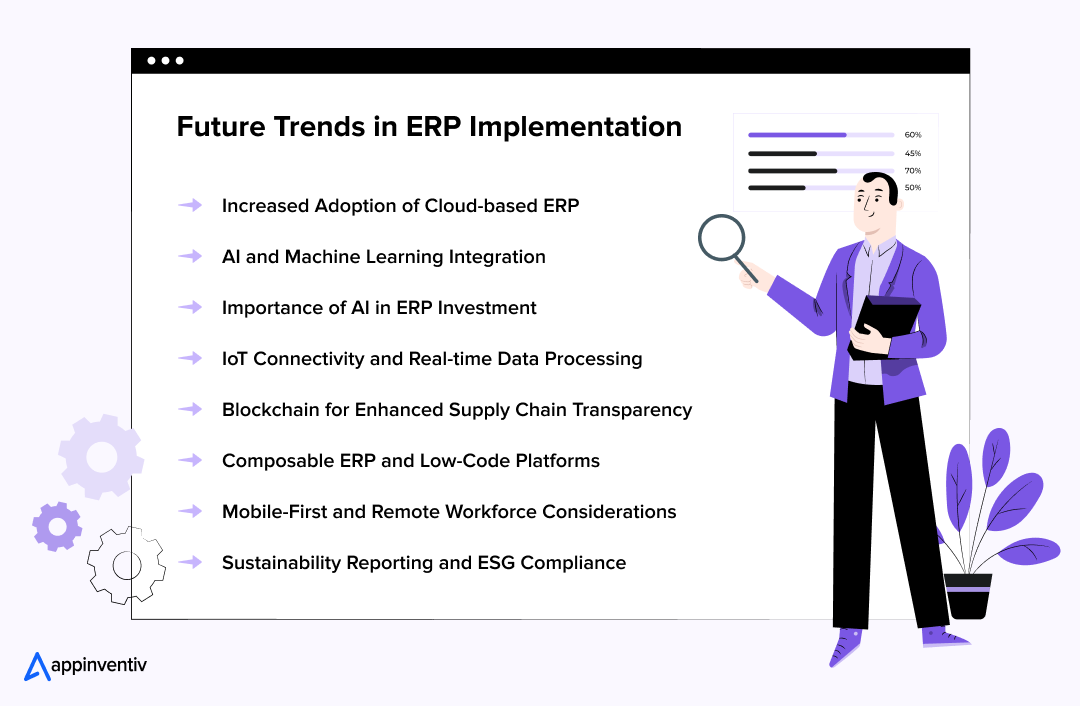
Increased Adoption of Cloud-based ERP
The shift from on-premise to cloud ERP is accelerating in Australia. Cloud solutions offer greater scalability, flexibility, and reduced infrastructure costs. Companies like MYOB Advanced and Oracle Fusion Cloud ERP (which partnered with the Australian Government) are leading this charge, highlighting the growing preference for accessible, agile, and secure cloud platforms.
AI and Machine Learning Integration
AI and ML are transforming ERP by enabling intelligent automation, predictive analytics, and enhanced decision-making. From forecasting demand with greater accuracy to automating customer service responses or optimizing supply chain routes, AI-powered ERPs are becoming indispensable.
Additionally, 40% of businesses surveyed said AI was an important consideration for their ERP application investment, and nearly 16% said embedded AI was a must-have. This trend reflects the growing recognition that ERP systems must serve as platforms for advanced analytics and intelligent automation (Source: Oracle NetSuite).
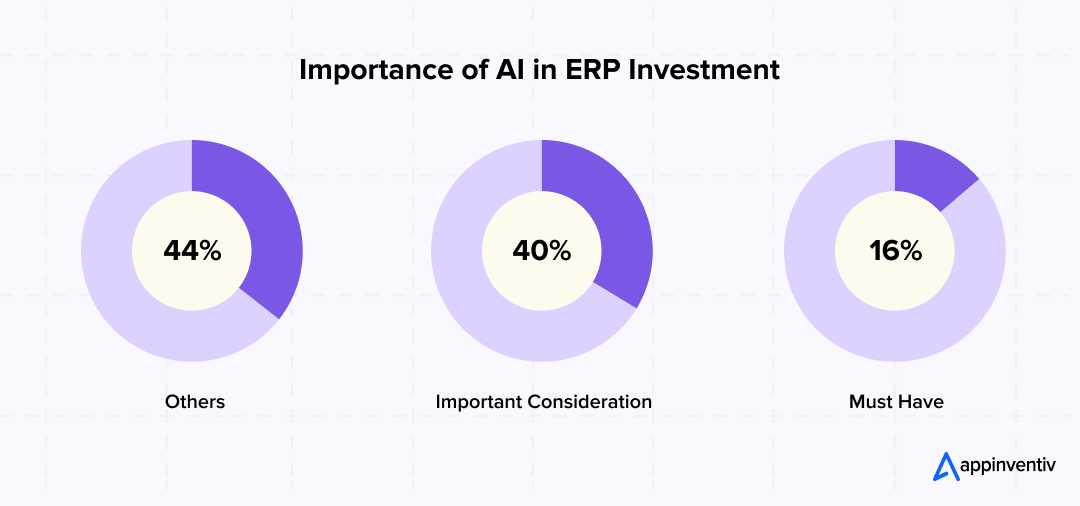
IoT Connectivity and Real-time Data Processing
The Internet of Things (IoT) brings real-time data from physical assets into the ERP system, enabling proactive maintenance, optimized asset utilization, and improved operational efficiency, particularly in manufacturing, logistics, and agriculture.
Also Read: How IoT is Transforming Industries: Benefits, Use Cases & More
Blockchain for Enhanced Supply Chain Transparency
Blockchain technology trends are emerging as a powerful tool for creating immutable, transparent records across complex supply chains, enhancing trust, traceability, and reducing fraud within ERP-managed processes.
Composable ERP and Low-Code Platforms
The trend towards composable ERP means building highly flexible, modular ERP solutions that can be easily adapted and extended using low-code/no-code platforms. This allows Australian enterprises to quickly respond to changing business needs without extensive custom development.
Mobile-First and Remote Workforce Considerations
With the rise of remote and hybrid work models, ERP solutions are increasingly designed with mobile accessibility and robust remote functionality in mind, ensuring employees can access critical data and perform tasks from anywhere.
Sustainability Reporting and ESG Compliance
Modern ERP systems are evolving to incorporate robust capabilities for tracking and reporting on environmental, social, and governance (ESG) metrics, enabling businesses to meet the growing demands for sustainability and corporate responsibility.
How Appinventiv Delivers Successful ERP Integration in Australia
At Appinventiv, we know ERP integration can feel overwhelming, especially with the unique challenges Australian businesses face. That’s why we take a tailored, hands-on approach—guiding you smoothly from disconnected systems to a fully unified, efficient ERP ecosystem.
Our tried-and-tested process of ERP integration in Australia covers every step, from choosing the right vendor and migrating your data to integration and ongoing support. We keep compliance front and center, ensuring your ERP solution aligns with Australian regulations, including data privacy and industry-specific standards.
But we don’t just stop at integration. We future-proof your business by harnessing the latest in AI, IoT, and cloud ERP technologies, so your system is not only powerful today but also ready for tomorrow’s demands.
For instance, we developed a powerful ERP solution for IKEA that allows walk-in customers to browse product catalogs via in-store tablets. Our approach combined a user-friendly catalog system with personalized promotional tools. This solution, now expanding to over 7 IKEA stores in the UAE, has become a key driver of ROI measurement for the world’s largest furnishing retailer.

With Appinventiv’s customizable ERP services, you can tackle inefficiencies, boost data accuracy, and deliver exceptional customer experiences—all setting the stage for long-term growth.
Partner with us, and confidently steer your digital transformation journey to stay ahead in Australia’s competitive landscape.
FAQs
Q. What is ERP Integration?
A. ERP integration essentially creates a central nervous system for your business. Instead of separate applications managing finance, human resources, supply chain, customer relationships, and manufacturing, an integrated ERP system provides a single source of truth for all business data.
This unification is achieved through various methods, including API integration, middleware, and direct database connections, ensuring that data entered in one module is immediately accessible and updated across all relevant parts of the system.
Q. How long does ERP integration take in Australia?
A. The duration of ERP integration in Australia varies based on several factors, including the complexity of the business, the size of the company, and the level of customization required. On average, the integration process can take anywhere from 3 months to a year or more.
For instance, smaller businesses with standard ERP needs may complete integration in just 3 to 6 months, while larger enterprises or those requiring heavy customization will take 6 months to 1 year or more.
It is essential to plan for adequate testing, data migration, and employee training as part of the overall timeline.
Q. How to ensure that integrated systems meet industry-specific compliance standards in Australia?
A. Ensuring that integrated ERP systems meet Australian compliance standards requires a thorough understanding of industry regulations. Here are the key steps to ensure compliance:
- Work with experienced ERP vendors who understand Australian regulations.
- Perform regular audits during the integration process to ensure compliance with local laws and industry standards.
- Customize the ERP system to incorporate compliance features, such as data protection and security protocols.
- Consult with legal and industry experts to ensure that the system addresses all relevant regulatory requirements.
- By collaborating with professionals who specialize in both ERP integration and compliance, businesses can minimize risks and ensure that their systems remain secure and compliant.
Q. How can LMS, eCommerce, and CRM systems integrate with ERP?
A. Integrating LMS, eCommerce, and CRM systems with ERP can significantly enhance business operations.
- LMS ERP integration ensures seamless management of learning and development data alongside other business functions, improving employee training efficiency.
- eCommerce ERP integration connects online stores with inventory and order management systems, streamlining sales processes and enhancing customer experience.
- CRM ERP integration (or ERP CRM integration) consolidates customer data with financial and operational systems, offering a unified view of customer interactions and boosting sales, marketing, and customer service efficiency.
These integrations help businesses achieve better data accuracy, faster decision-making, and improved operational efficiency.
IT Managed & Outsourcing
Didn't find what you're looking for? Let us know your needs, and we'll tailor a solution just for you.



